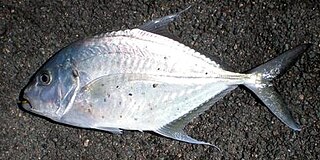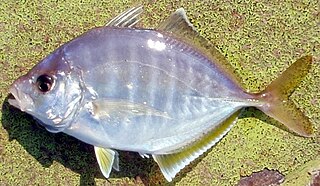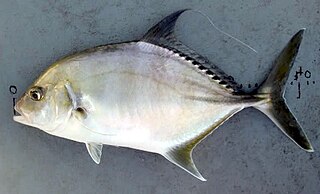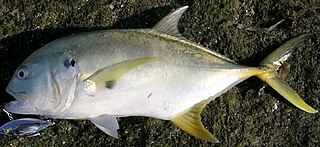
The crevalle jack, also known as the common jack, black-tailed trevally, couvalli jack, black cavalli, jack crevale, or yellow cavalli is a common species of large marine fish classified within the jack family, Carangidae. The crevalle jack is distributed across the tropical and temperate waters of the Atlantic Ocean, ranging from Nova Scotia, Canada to Uruguay in the western Atlantic and Portugal to Angola in the eastern Atlantic, including the Mediterranean Sea. It is distinguishable from similar species by its deep body, fin colouration and a host of more detailed anatomical features, including fin ray and lateral line scale counts. It is one of the largest fish in the genus Caranx, growing to a maximum known length of 124 cm and a weight of 32 kg, although is rare at lengths greater than 60 cm. The crevalle jack inhabits both inshore and offshore waters to depths of around 350 m, predominantly over reefs, bays, lagoons and occasionally estuaries. Young fish dispersed north by currents in the eastern Atlantic are known to migrate back to more tropical waters before the onset of winter; however, if the fish fail to migrate, mass mortalities occur as the temperature falls below the species' tolerance.

The bigeye trevally, also known as the bigeye jack, great trevally, six-banded trevally and dusky jack, is a species of widespread large marine fish classified in the jack family Carangidae. The bigeye trevally is distributed throughout the tropical waters of the Indian and Pacific Oceans, ranging from South Africa in the west to California and Ecuador in the east, including Australia to the south and Japan in the north. The bigeye trevally is best distinguished by its colouration, having a dark second dorsal fin with a white tip on the lobe, and also possessing a small dark spot on the operculum. Other more detailed anatomical features also set the species apart from other members of Caranx. The species is known to grow to a length of 120 cm and 18 kg.

The orange-spotted trevally, Carangoides bajad is a species of inshore marine fish in the jack family, Carangidae. The species is fairly common in tropical to subtropical waters of the Indo-Pacific, ranging from Madagascar in the west to Japan in the east, typically inhabiting inshore reefs. The species has characteristic orange-yellow spots on its sides, although counts of fin rays and scutes are needed to distinguish it from related species with similar colouring. Orange-spotted trevallies are powerful predators, taking a variety of small fish, nekton, and crustaceans, and reach sexual maturity around 25 cm long. It is a moderately large fish, reaching a maximum known length of 55 cm. The species is occasionally taken by fishermen throughout its range, and is generally considered to be bycatch. The exception to this is in the southern Persian Gulf, where it makes up a large proportion of the fishery.

The shrimp scad, is a species of widespread tropical marine fish of the jack family, Carangidae. The shrimp scad is widely distributed in the tropical and subtropical western Indian Ocean and areas of the eastern Pacific Ocean, ranging from South Africa in the west to Hawaii in the east, including Japan and Australia to the north and south. The species is commonly found on inshore reefs and sandy substrates. It has the common body profile of a scad, and may be difficult to differentiate from others in the genus Alepes. It is one of the larger scads, growing to 40 cm, but often is encountered at much smaller sizes. The shrimp scad often forms large schools, and is carnivorous, consuming a variety of crustaceans and small fish. It is of moderate importance to fisheries throughout its range.

The horse-eye jack, also known as the big-eye jack, is a game fish and minor commercial fish in the family Carangidae. Its appearance is similar to that of the crevalle jack, although the horse-eye jack's head is not as blunt. The horse-eye jack is known to feed on smaller fish and on many invertebrates, such as shrimp and crab.

Caranx lugubris, the black jack, black trevally, black kingfish, coal fish or black ulua, is a species of large ocean fish in the jack family Carangidae. The species has a circumtropical distribution, found in oceanic, offshore waters of the tropical zones of the Pacific, Atlantic and Indian Oceans. The species is particularly prevalent around offshore islands such as the Caribbean islands in the Atlantic, Hawaii and French Polynesia in the Pacific and the Seychelles and Maldives in the Indian Ocean. Black jack are rare in shallow waters, preferring deep reefs, ledges and seamounts in clear waters. The species is easily distinguished by its black to grey fins and jet black scutes, with the head having a steep profile near the snout. The largest recorded length is 1 m and weight of 17.9 kg. The black jack lives either individually or in small schools, and is known to school with other species. It is a predatory fish, taking a variety of fish, crustaceans and molluscs as prey. Sexual maturity is reached at 34.6 cm in females and 38.2 cm in males, with spawning taking place between February and September in the Caribbean. The early life history of the species is very poorly understood. Black jack are of high importance to many island fisheries, but are rarely encountered in most continental fisheries. The species has a reputation as a gamefish, and is variably considered a terrible or excellent food fish, although several cases of ciguatera poisoning have been attributed to the species. The species was initially named Caranx ascensionis by Georges Cuvier, however several issues with the use of this name have seen Felipe Poey's name Caranx lugubris become the valid scientific name.

The longnose trevally, also known as the tea-leaf trevally, club-nosed trevally, grunting trevally or dusky trevally, is a species of inshore marine fish in the jack family, Carangidae. The species is distributed throughout the tropical and subtropical waters of the Indian and west Pacific Oceans from South Africa to New Zealand and Japan, inhabiting coastal waters, especially reefs, to a depth of 90 m. The longnose trevally is distinguished from similar species by a combination of a scaleless breast and the number of gill rakers and fin rays. It is a moderately large fish, growing to a maximum known length of 72 cm and 4.35 kg. The longnose trevally is a predatory fish, consuming small fish, crustaceans and molluscs. The species is of minor commercial importance throughout its range, and is considered to be a good table fish.

The coastal trevally, also known as the onion trevally, Japanese trevally or bluefin kingfish, is a species of inshore marine fish in the jack family Carangidae. The species is distributed throughout the tropical and subtropical waters of the Indian and west Pacific Oceans, from South Africa in the west to Japan and New Caledonia in the east, reaching as far south as Australia. The species is found on deep coastal reefs, both in schools and as solitary individuals, where they prey on small midwater organisms including crustaceans, small fish and cephalopods. The species is taken as bycatch in a number of fisheries throughout its range by a number of fishing methods and is of little commercial value, but is considered to be a good table fish. A mistype in the original volume in which Eduard Rüppell named the species led to the combination Carangoides caeruleopinnatus, which has incorrectly spread through the literature.

The green jack, also known as the horse jack, is an abundant species of coastal marine fish in the jack family Carangidae. The species is distributed in the eastern Pacific Ocean along the American coastline from Santa Cruz Island off California in the north to Peru in the south, as well as a number of islands including the Galapagos and recently, Hawaii. The green jack is distinguished from other similar carangid species by a number of features including gill raker and lateral line scale counts, and the presence of an adipose eyelid. It is a moderately large species, growing to at least 55 cm in length and 2.81 kg, although unconfirmed reports suggest a much larger maximum size. It lives in a wide range of continental shelf environments including estuaries, bays, reefs and offshore seamounts, living both pelagically and demersally. The green jack is a predatory species, preying on a variety of fish, crustaceans and cephalopods, as well as zooplankton. Most fish are sexually mature by the time they attain 38 cm, with spawning occurring between May and October. The species is of high importance to fisheries throughout its range, caught by pelagic trawls, a variety of netting methods and hook and line. The green jack is also of interest to anglers, taken by bait and lures, although is considered to only be fair in eating quality.

Caranx is a genus of tropical to subtropical marine fishes in the jack family Carangidae, commonly known as jacks, trevallies and kingfishes. They are moderate- to large-sized, deep-bodied fishes which are distinguished from other carangid genera by specific gill raker, fin ray and dentition characteristics. The genus is represented in the Pacific, Indian and Atlantic Oceans, inhabiting both inshore and offshore regions, ranging from estuaries and bays to deep reefs and offshore islands. All species are powerful predators, taking a variety of fish, crustaceans and cephalopods, while they in turn are prey to larger pelagic fishes and sharks. A number of fish in the genus have a reputation as powerful gamefish and are highly sought by anglers. They often make up high amounts of the catch in various fisheries, but are generally considered poor to fair table fishes.

The whitefin trevally, also known as the horse trevally, is a species of deep water offshore fish in the jack family Carangidae. The species inhabits the tropical to temperate waters of the Indo-Pacific and central Pacific, ranging from South Africa in the west to Hawaii in the east. The whitefin trevally is a moderate-sized fish, growing to 37 cm, and is distinguished by a number of morphological traits, including fin size, gill raker count, and colour. It inhabits the continental shelf and slope at depths to 200 m over sand and mud substrates, where it preys on fish, crustaceans, and cephalopods. Studies in Japan indicate a length at sexual maturity of 17.4 cm on average, with spawning occurring between May and October, with each individual spawning multiple times. Whitefin trevallies are of high importance to fisheries in Japan, where they are taken by trawlers, although the catch numbers have halved since the 1980s. It is of minor importance elsewhere throughout its range, but is considered a good table fish.

The blue trevally, also known as the banded trevally, barred trevally, Ferdau's trevally or Forskaal's jackfish, is a common, widespread species of pelagic marine fish classified in the jack family, Carangidae. The blue trevally is distributed throughout the tropical and subtropical waters of the Indo-Pacific and central Pacific regions, ranging from South Africa in the west to Hawaii in the east. It is a moderately large fish, growing to a recorded maximum length of 70 cm, with the number of rays in the second dorsal fin and the colouring serving as diagnostic features of the species. The species inhabits waters to depths of 60 m, generally inhabiting reefs, beaches, lagoons, and areas with sandy substrates. It is a predatory fish, taking other fish, prawns, crabs, and molluscs, and very little is known of the species' reproductive biology. The blue trevally is of varying importance to fisheries throughout its range, with some regions having high catches of the fish. It is considered to be a gamefish, and is sought after for its excellent eating qualities.

The coachwhip trevally, also known as the oblong trevally or oblique-banded trevally, is a species of inshore marine fish classified in the jack family Carangidae. The coachwhip trevally is distributed through the Indo-west Pacific region, ranging from South Africa in the west to Fiji and Japan in the east. It is a moderately large fish, growing to a known maximum length of 46 cm and can be distinguished from similar species by an array of detailed morphological features including dentition, fin ray counts and scale patterns. The coachwhip trevally inhabits coastal waters throughout its range, known to prefer estuarine waters in a number of localities. Nothing is known of its diet or reproductive biology, and is of little importance to fisheries, occasionally taken as bycatch in trawl and hook and line fisheries.

The barcheek trevally, also known as the barcheek kingfish, shortridge trevally or oblique-banded trevally, is a species of moderately large marine fish of the jack family Carangidae. The barcheek trevally is distributed throughout the tropical waters of the Indo-west Pacific region, ranging from South Africa in the west to Japan, Australia and a number of small central Pacific islands in the east. The species inhabits inshore and offshore waters, found along the slopes of lagoons and out to deeper reefs on the continental shelf, where it preys on small fish and benthic crustaceans. It is a moderately large fish, growing to a maximum recorded length of 50 cm, and can be distinguished from similar species by its somewhat protruding lower jaw and the dark banding on its operculum. It is of minor importance to fisheries throughout its range, taken by trawling, hook and line methods and various inshore fish netting methods.

The Pacific crevalle jack is a species of large marine fish classified in the jack family Carangidae. The species is distributed through the tropical waters of the eastern Pacific Ocean from California in the north to Peru in the south, including several offshore islands. The species is best identified by its deep body and mostly unscaled breast, as well as other more detailed anatomical features. The species is known to grow to a maximum length of 101 cm and a weight of 19.7 kg. Disagreement on the status of the species has been significant in the scientific literature, with many claiming it to be conspecific with or subspecific to the Atlantic Caranx hippos. The most recent review of the crevalle jacks strongly concluded it to be a separate species based on the development of hyperostosis and fin colouring. It is predominantly a schooling inshore species, inhabiting sandy and rocky substrates, although larger individuals are occasionally found living pelagically to depths of 350 m. The Pacific crevalle jack is a fast-swimming predator, taking a variety of fish, crustaceans, and other small invertebrates. Spawning is thought to occur year-round, although peaks occur during November and May. The Pacific crevalle jack is an important species to commercial fisheries, with data available from Colima in Mexico indicating it accounts for up to 15% of the entire yearly catch. Pacific crevalle jack are highly rated gamefish, taken by both bait and a variety of lures, but are considered relatively poor quality food.

The imposter trevally, also known as the imposter jack or white-tongued trevally, is a species of small coastal marine fish in the jack family Carangidae. The imposter trevally is distributed through the tropical waters of Indian and west Pacific oceans, from the Gulf of Oman in the west to Japan and Australia in the east. The species is quite similar to the Malabar trevally, but can be distinguished by its gill raker count, and is identifiable from other species by having a white to pale grey tongue. It is a relatively small species, growing to a maximum recorded length of 30 cm. The imposter trevally inhabits coastal waters of the continental shelf in depths of up to 140 m, often associating with closely related carangid species. It preys on a range of small fish, crustaceans and cephalopods, but little is known of its reproductive biology. The imposter trevally is of minor importance to fisheries throughout its range, taken by hook and line, bottom trawls and several types of artisanal gear.

The longfin crevalle jack is a recently described species of large marine fish classified in the jack family, Carangidae. It inhabits the subtropical waters of the east Atlantic Ocean, ranging along the African coast from Mauritania south at least to Moçamedes in southern Angola, with the species historically present in the Mediterranean Sea. It is an inshore species, known to occasionally penetrate estuaries, possibly to spawn. The species is very similar to the crevalle jack, Caranx hippos, and is separated by its extended dorsal and anal fin lobes as well as more detailed anatomical features including dorsal and anal fin ray counts. The fish is known to reach 127 cm in length and 20.9 kg in weight. The longfin crevalle jack is a predatory fish, taking small fish as its main prey. Due to longstanding confusion between C. fischeri and C. hippos, the importance of each species to African fisheries is poorly understood, with a known combined catch in this region of between 2,233 and 10,054 tonnes per year in 1995–2004. Like its close relatives, the species is considered a powerful gamefish and highly sought after, although their coarse flesh makes for relatively poor quality food.

The brassy trevally, Caranx papuensis is a species of large marine fish classified in the jack family, Carangidae.

The Senegal jack, also known as the African jack, is a species of large marine fish classified in the jack family Carangidae. The species is distributed through the tropical waters of the eastern Atlantic Ocean, ranging along the west African coast from Angola in the south to Mauritania in the north. It can be distinguished from co-occurring relatives by its longer dorsal fin lobe, as well as a host of other anatomical features. The Senegal jack grows to a known maximum length of 1 m. It is a coastal species, known to live semi-pelagically, inhabiting both the sea floor and surface waters to depths of around 200 m. The Senegal jack is a predatory species, taking fish, crabs and shrimps as its main prey items. The species reaches sexual maturity at 21 cm in females and 24 cm in males, with spawning occurring in two periods; February to April and September to November. The species is of minor importance to fisheries, and is not discriminated from other jacks in catch statistics. It is taken by trawls, seines and hook and line, and sold fresh or preserved.

The tille trevally, also known as the tille kingfish, is a species of large marine fish classified in the jack family, Carangidae. The tille trevally is distributed through the tropical and subtropical waters of the Indo-Pacific region, ranging from South Africa in the west to Fiji, Japan and Australia in the east. The species is best distinguished by its rounded, strongly convex anterior profile, with other detailed anatomical features also useful. The tille trevally reaches a maximum length of 80 cm and a weight of 7.2 kg. It is predominantly an inshore species, inhabiting coastal reef and lagoon environments, although has been recorded on deep offshore seamounts. It is a predatory fish, taking various species of fish and crustaceans as prey, with little known of its reproductive cycle. It is of minor importance to fisheries throughout its range, taken by hook and line, gill nets and purse seines. The tille trevally is also considered a good game fish, and an excellent table fish. The species acquired its scientific and common names from a local name used by Pondicherry fishermen, koton tille, which Georges Cuvier then used when he named the species in 1833.
























